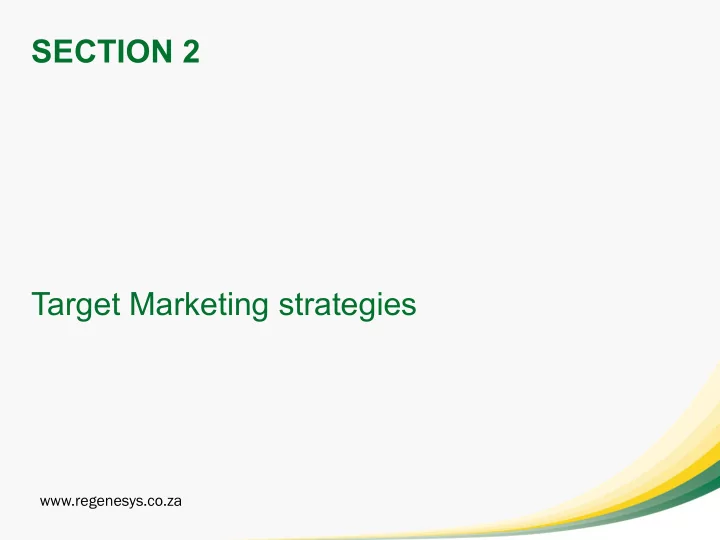

SECTION 2 Target Marketing strategies www.regenesys.co.za
INTRODUCTION Understanding and defining the market place is the first step in the basic marketing process - presented in the previous section This is a complex, challenging, and constantly changing environment The market for a particular item is made up of existing and potential customers who need it and “have the ability and willingness to pay for it” (Business Dictionary.com, 2016) www.regenesys.co.za
MARKETS A market is a mechanism for -determining price for a traded item. -communicating price information. -facilitating deals and transactions -effecting distribution. www.regenesys.co.za
BUSINESS PRODUCT It is “any product that is used to produce another product, which becomes part of another product or that is used in the daily operations of a company; or that is resold to other customers” (Lamb et al, 2015:544) www.regenesys.co.za
EXAMPLES OF BUSINESS PRODUCTS Major equipment (truck, bull dozers) Accessory equipment (personal computer, office equipment Components parts (tyres, electric pumps in engine). Processed materials (sheet metals, chemicals) Supplies (cleaning materials, ink) Business services (legal, financial, cleaning services) www.regenesys.co.za
DIFFERENCES BETWEEN BUSINESS AND CONSUMER MARKETS Buyi ying ng c cha haracteristic B2B ma market B2C ma market Demand Whole org Individual Size of order Larger Smaller # of customers Fewer Many Location of buyers Geographically Widely distributed concentrated Distribution structure More structured More personal Buying influence Multiple Single Type of negotiation Complex Simpler Use of leasing Greater Lessor Primary Promotional Personal selling Advertising method (Source: Lamb et al, 2015;546) www.regenesys.co.za
B2B CUSTOMERS Producers Resellers National and local government departments Institutions www.regenesys.co.za
A MODEL OF BUSINESS BUYER BEHAVIOUR www.regenesys.co.za
A MODEL OF BUSINESS BUYER BEHAVIOUR Buying situation New task buying • Straight rebuy • Modified rebuy • Buying centre Users • Influencers • Buyer • Decision-maker • Gatekeeper • Marketing challenges of the buying centre • www.regenesys.co.za
A MODEL OF BUSINESS BUYER BEHAVIOUR Business buying process Refer to table 6 in your guide and complete • the activity on B2B marketing trends www.regenesys.co.za
A MODEL OF BUSINESS BUYER BEHAVIOUR www.regenesys.co.za
A MODEL OF BUSINESS BUYER BEHAVIOUR www.regenesys.co.za
TARGET MARKETING STRATEGIES IN BUSINESS MARKETS The central focus of marketing should be to create customer value and to build profitable customer relationships Step 1: Market segmentation Step 2: Market targeting Step 3: Differentiation Step 4: Positioning Complete the activity in your guide – basic segmentation concepts (pp 75) www.regenesys.co.za
ACTIVITY: SEGMENTATION FACTORS Aim: -To identify participants’ knowledge of segmentation factors Time: • 3 minutes: Asking participants questions on segmentation factors • 3 minutes: Facilitator feedback and closure Task: To discuss segmentation factors with participants www.regenesys.co.za
BASES FOR MARKET SEGMENTATION Market segmentation addresses the first simple sounding marketing question from figure 5: Which customers will we serve? We know that consumer markets can be segmented geographically, demographically, psychographically, and behaviourally The business market can be segmented geographically, demographically (by industry, company size), or by benefits sought, user status, usage rate, and loyalty status www.regenesys.co.za
BASES FOR MARKET SEGMENTATION Business marketers also use some additional segmentation variables, such as: Customer operating characteristics • Purchasing approaches • Situational factors • Personal characteristics • Segmenting business markets Refer to table 7 in your guide (pp 77) • www.regenesys.co.za
REQUIREMENTS FOR EFFECTIVE SEGMENTATION To be useful to a marketer, a segment must meet five requirements. Segments must: • Measurable • Accessible • Substantial • Differentiable • Actionable www.regenesys.co.za
MARKET TARGETING Evaluating market segments Segment size and growth • Structural attractiveness • Company objectives and resources • Selecting target market segments Broad • Narrow • Choosing a targeting strategy Company’s resources • Degree of product variability • Life cycle stage • Market variability • Competitors marketing strategies • www.regenesys.co.za
DIFFERENTIATION AND POSITIONING FOR COMPETITIVE ADVANTAGE What is product positioning? Differentiation: the cornerstone of positioning Positioning maps Choosing a differentiation and positioning strategy Remember to answer the recap and discussion questions in your guide www.regenesys.co.za
SECTION 2: SUMMARY Learning outcomes covered: Determine positioning strategy by analysing and interpreting market information. Undertake market segmentation and identify target markets. Discuss STDP and importance to the organisation www.regenesys.co.za
Recommend
More recommend